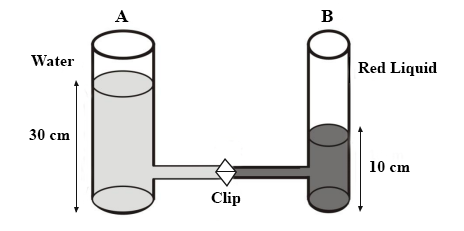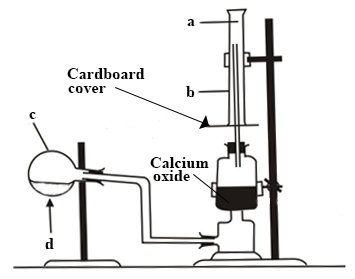1.
A metre rule can be used for measuring the
volume of a liquid.
area of a ball.
length of a table.
diameter of a wire.
2.
Heat travels through vacuum by
conduction.
convection.
radiation.
convection and radiation.
3.
A mirror is used to direct sunlight onto the wall of a classroom by
dispersion.
refraction.
reflection.
radiation.
4.
Which of the following energy changes takes place in ringing bell?
Potential to kinetic
Potential to sound
Mechanical to sound
Sound to light
5.
A fuse is connected in an electric circuit to
prevent electric shock.
increase the current.
prevent current from increasing.
increase the heat generated.
6.
Which of these objects is a magnetic substance?
Aluminium
Brass
Copper
Iron
7.
Which of the following bodies are natural sources of light?
I. Moon
II. Sun
III. Firefly
I and II only
I and III only
II and III only
I, II and III
8.
Which of the following statements describes the nature of light?
It passes through all objects.
It is absorbed at a polished surface.
It travels in a straight line.
It is always reflected in a medium.
9.
Metals are able to conduct electricity because they possess
free electrons.
neutrons.
atoms.
free protons.
10.
Beriberi is caused by deficiency of vitamin
A.
B.
E.
K.
11.
Which of the following fruits is adapted for dispersal by air?
Succulent fruit
Brightly coloured fruit
Sticky fruit
Hairy fruit
12.
The food substance needed for growth and repair of tissue is
carbohydrates.
oil.
protein.
vitamin.
13.
The type of teeth used for biting and cutting are the
canines.
incisors.
molars.
premolars.
14.
Water is absorbed by roots in plants and transported to the leaves through the
chlorophyll.
phloem.
stomata.
xylem.
15.
The outer ear consists of the
ossicles and eardrum.
cochlea and pinna.
ossicles and cochlea.
pinna and eardrum.
16.
Changes in pressure in the middle ear is regulated by the
ampullae.
cochlea.
eustachian tube.
ear drum.
17.
The amount of light that enters the eye is reduced by the size of the
lens.
iris.
pupil.
retina.
18.
In humans, features of parents are passed on to offspring through
breastfeeding.
reproduction.
good training.
sharing the same things.
19.
The taste of water changes when it is boiled because
heat is absorbed during boiling.
evaporation takes place during boiling.
air is lost during boiling.
steam is produced during boiling.
20.
Arrange the following types of water in order of increasing hardness.
I. Tap water
II. Sea water
III. Distilled water
IV. Rain water
IV, III, II, I
III, IV, I, II
II, I, IV, III
I, II, III, IV
21.
Which of these methods is used to separate insoluble solids from liquids?
Distillation
Evaporation
Filtration
Winnowing
22.
A uniform mixture of two or more metals is called
an alloy.
a compound.
a solvent.
a suspension.
23.
Which of the following liquids cannot dissolve an oil paint?
Kerosene
Petrol
Turpentine
Water
24.
An atom which contains more electrons than protons becomes a
positive ion.
negative ion.
neutral atom.
binary compound.
25.
The following substances are mixtures except
air.
carbon dioxide.
salt solution.
smoke.
26.
The fish is protected from injury by the
fins.
gills.
operculum.
scales.
27.
Which of the following substances is an air pollutant?
Water vapour
Oxygen
Nitrogen
Hydrogen sulphide
28.
Bathing in lakes and slow moving streams can lead to one getting
bilharziasis.
cholera.
dysentery.
river blindness.
29.
Some plants shed their leaves during the dry season to prevent
water loss.
heat loss.
catching fire.
losing nutrients.
30.
Caterpillar is an example of
an animal parasite that feeds on plant host.
a plant parasite that lives on an animal host.
an animal parasite that feeds on animal host.
a plant parasite that grows on plant host.
31.
How long does it take the moon to go completely round the earth?
1 day
28 days
30 days
365 days
32.
An unripe orange is said to be acidic because it
has low sugar content.
has bitter taste.
turns red litmus paper blue.
turns blue litmus paper red.
33.
The chemical symbol of potassium is
K.
N.
P.
S.
34.
The property of a metal that makes it possible for it to be drawn into a wire is called
conductivity.
ductility.
malleability.
resistivity.
35.
Which of the following methods of preserving food make use of heat energy?
I. Drying
II. Frying
III. Salting
IV. Canning
I and II only
I and IV only
III and IV only
I, II and III only
36.
Weight is an example of
energy.
force.
work.
power.
37.
Blood is prevented from flowing back into the veins by the
arteries.
capillaries.
heart.
valves.
38.
The force that binds molecules of the same substances together is called
adhesion.
cohesion.
capillary action.
surface tension.
39.
Soluble digested food substances enter the blood of the human body by a process called
absorption.
egestion.
excretion.
ingestion.
40.
Capillary action is applied in the following activities except
blotting an ink with a blotting paper.
absorption of water with a towel.
rising of water in a very narrow glass tube.
sticking of water droplets on the surface of a glass tube.
(a)

In an experiment, as in the set-up above, two glass containers A and B of different sizes are joined together with a tube and clipped.
Water is poured into container A to a height of 30 cm and a red liquid is poured into B to a height of 10 cm. The clip is then removed so that the liquids join together.
(i)
State two observations that will be made immediately the clip is removed.
(ii)
Explain the observations in (i).
(iii)
What two observations will be made after a long time? Explain.
(b)
The set-up below is used in the preparation of ammonia gas in the laboratory
Study it and answer the questions that follow.

(i)
Name the parts labelled a, b and c
(ii)
What is the meaning of the arrow sign d?
(iii)
What is the function of the calcium oxide?
(iv)
Why has c been tilted downwards?
(v)
State the method by which the gas is collected.
(vi)
How will you test for the gas?
(vii)
Give the names and the chemical formulae of the compounds that form the content of c.
(c)
In an experiment, a leaf that is partly green and partly yellow is plucked from a tree and the leaf is
I boiled for a minute,
II dipped in warm alcohol,
III washed in cold water,
IV dipped in iodine solution.
One part of the leaf turns blue-black after the dipping in iodine solution while the other part remains unchanged.
(i)
Explain why each of the processes I, II and III
(ii)
Which part of the leaf turns blue-black? Explain.
(iii)
Why does the other part of the leaf not change colour?
(iv)
What conclusion can you draw from the experiment?
(a)
(i)
State the difference between an opaque object and a translucent object
(ii)
Give one example each of an opaque and a translucent material.
(b)
(i)
What is the importance of seed dispersal?
(ii)
Name two types of fruits and state their mode of dispersal.
(c)
(i)
What is recycling?
(ii)
Give two advantages of recycling of materials.
(iii)
List three recycled products in Ghana.
(a)
(i)
Explain the term bedwetting?
(ii)
State two diseases that may result from bedwetting.
(b)
(i)
State the difference between hard water and impure water.
(ii)
Give the stages involved in the treatment of water for a community.
(c)
A piece of stone has a mass of 36.0 g. When it is put into water in a glass container, the level of water rises from 60.0 cm3 to 90.0 cm3.
(i)
Calculate the density of the stone.
(ii)
Explain what will be observed when the stone is put into another liquid of density 1.4 gcm-3?
(a)
(i)
What is an echo?
(ii)
State two uses of echoes.
(b)
(i)
State three diseases that affect the respiratory system of human.
(ii)
Name one method each by which the diseases you have named can be prevented.
(c)
(i)
What is biotechnology?
(ii)
List three products that are obtained from biotechnology.
(a)
(i)
Define pressure
(ii)
State three applications of pressure in everyday life
(b)
State four functions of the liver in digestion.
(c)
(i)
What is a compound?
(ii)
Give two properties of a compound
(iii)
Write down the name and the chemical formula of the compound formed between the following elements:
(α)
hydrogen and chlorine
(β)
magnesium and oxygen